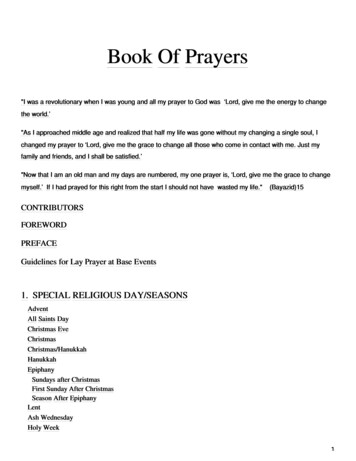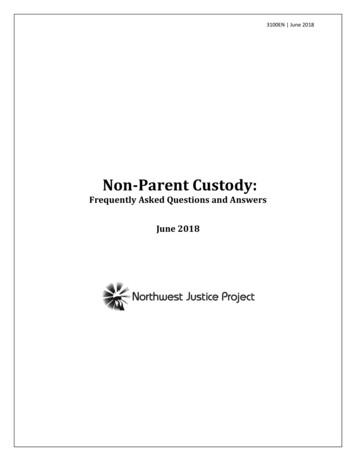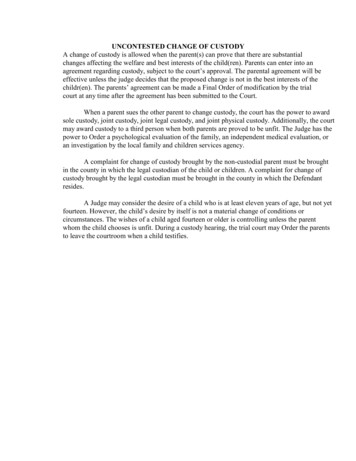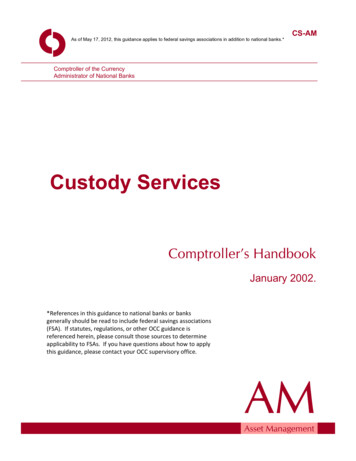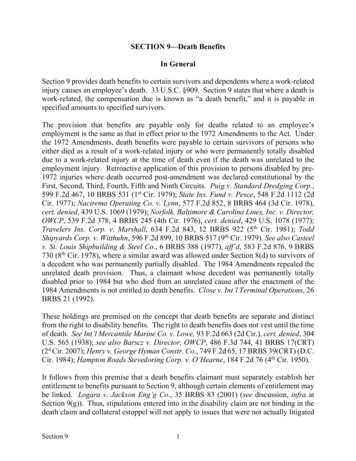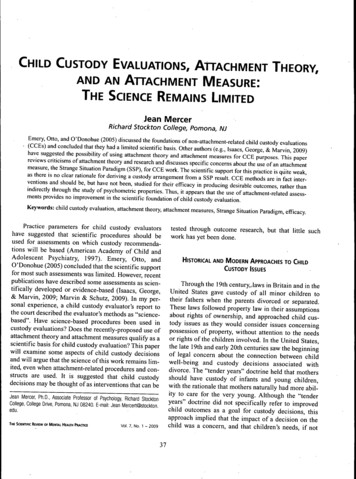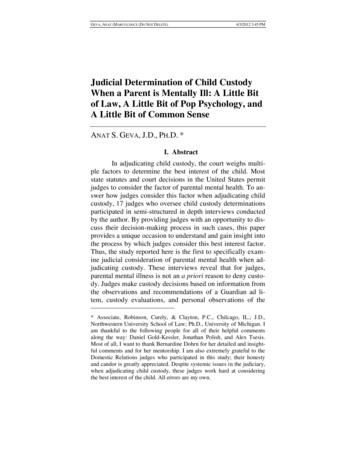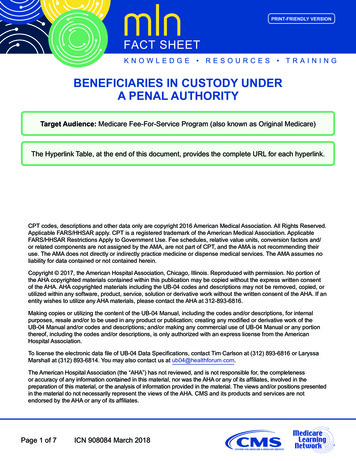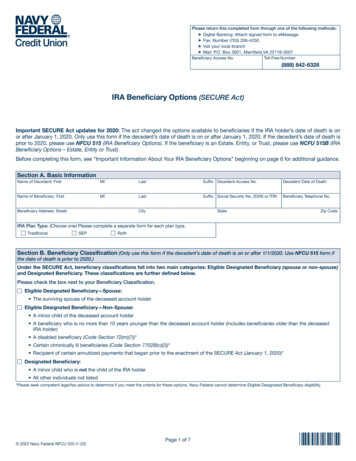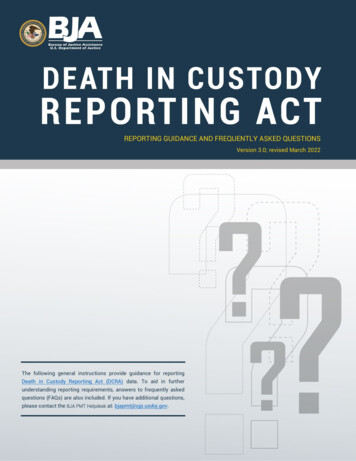
Transcription
Death in Custody Reporting Act: Reporting Guidance and Frequently Asked Questions1REPORTING GUIDANCE AND FREQUENTLY ASKED QUESTIONSVersion 3.0; revised March 2022The following general instructions provide guidance for reportingDeath in Custody Reporting Act (DCRA) data. To aid in furtherunderstanding reporting requirements, answers to frequently askedquestions (FAQs) are also included. If you have additional questions,please contact the BJA PMT Helpdesk at: bjapmt@ojp.usdoj.gov.
Death in Custody Reporting Act: Reporting Guidance and Frequently Asked QuestionsGeneral InstructionsThe Death in Custody Reporting Act (DCRA; Pub. L. No. 113-242) requires states to report to theAttorney General information regarding the death of any person who is either; detained, under arrest, inthe process of being arrested, en route to be incarcerated, or is incarcerated at a municipal or county jail,state prison, state-run boot camp prison, boot camp prison that is contracted out by the state, any stateor local contract facility, or other local or state correctional facility (including any juvenile facility). Thesedeath-in-custody data were originally captured by the Bureau of Justice Statistics’ Mortality inCorrectional Institutions data collection.State Administering Agencies (SAAs) are responsible for collecting data on a quarterly basis from stateand local entities including law enforcement agencies, local jails, correctional institutions, medicalexaminers, and other state agencies. SAAs are responsible for compiling and aggregating the data forsubmission to the Bureau of Justice Assistance (BJA).Each quarter, states must either (1) report all deaths in custody that occurred in their jurisdictions duringthe corresponding quarter and provide basic information about the circumstances of those deaths or (2)affirm that no deaths in custody occurred in their jurisdictions during the reporting period.States must answer questions related to deaths in custody in BJA’s Performance Measurement Tool(PMT) and submit the information by the reporting deadline. The reporting deadline is the last day of themonth following the close of the quarter (January, April, July, October).For each death in custody, states must enter the following information into the PMT: The decedent’s name, date of birth, gender, race, and ethnicityThe date, time, and location of the deathThe law enforcement or correctional agency that detained, arrested, or was in the process ofarresting the deceased; andA brief description of the circumstances surrounding the deathStates must sufficiently answer all questions related to deaths in custody before they can submit theinformation in the PMT. If a state does not have sufficient information to complete certain dataelements, they may enter “unknown” data values (when allowed in the PMT). For cases that remainunder investigation, the “manner of death” should be reported as “unavailable, investigation pending,”and the state should specify when it anticipates obtaining the information. Once the information isavailable, states will need to have the PMT Helpdesk unlock their reports to update them. If theinformation is not updated, BJA will follow up with states in subsequent reporting periods to updateprevious entries.Frequently Asked QuestionsI. GENERAL INFORMATION1. Which documents and resources should be followed to comply with DCRA reporting requirements?While BJA is aware that former BJA-supplied DCRA reporting guidance documents are still postedon certain websites (e.g., state-specific websites), any and all guidance from BJA should bereplaced with the following three primary documents: this FAQ document, the DCRA Factsheet, andthe DCRA Performance Measure Questionnaire.Several trainings are available online regarding DCRA reporting that have been hosted and recordedon BJA’s YouTube channel. BJA recognizes that states may provide additional guidance and toolsto state and local agencies, which we leave to the discretion of the state to assist in their own datacollection process.Also, a “bulk upload” feature is available to states for the purpose of uploading multiple decedentrecords at a time.2
Death in Custody Reporting Act: Reporting Guidance and Frequently Asked Questions2. My jurisdiction accepted the FY 2019 JAG award late. Do we still need to report data that wasrequired by accepting the award?Even if your jurisdiction was late in accepting the FY 2019 award, you are still required to reportDCRA data within the PMT dating back to the October 1–December 31, 2019, reporting period, whichis the first quarter that DCRA reporting was required under JAG. If you have questions about backreporting, contact the PMT Helpdesk.3. Which state agency is ultimately responsible for DCRA data collection and reporting to BJA?DCRA reporting is tied to JAG reporting. As such, the SAA is ultimately responsible for setting uppolicies and procedures to ensure that DCRA reporting is complete.4. Is there a limit to the number of decedents that can be reported in the PMT each quarter?Yes. You can enter up to 1,000 decedent records each quarter.5. Is there a point of contact (POC) list for all jails?BJA does not have a list of jail POCs to share. It is up to each state to determine which facilities arerequired to participate.6. Will states that are not compliant have an opportunity to apply for DCRA reallocation funds?If the Department of Justice (DOJ) decides to apply penalties to noncompliant states, those statesmay have the opportunity to apply for those unobligated funds to use toward bringing DCRA datacollection into compliance.II. REPORTING1. What kind of information am I reporting?You will report all decedent information, as required in the statute. The DCRA Performance MeasureQuestionnaire contains all of the information you are required to report.2. Has DCRA collection been approved by the Office of Management and Budget (OMB) as part of theprocess established under the Paperwork Reduction Act?Yes, the current DCRA collection OMB number is 1121-0365 and the expiration date is July 31, 2024.3. Is the Social Security Number (SSN) of decedents required?No. An SSN field was included in an early version of the reporting form as an optional field to ensurethat duplicate decedents were not entered into the system. Trainings at the beginning of the BJADCRA data collection were based on that version of the reporting form. However, BJA has sinceremoved the SSN field from the reporting form based on feedback from states. The SSN field is nolonger required, nor does it appear on the reporting form in the PMT.4. Each quarter, we are asked to report whether there has been at least one reportable death in thestate during the reporting period. Do we have to get an “affirmative no” response from all agencies?Can we assume that if we do not hear from an agency, then there was no reportable death?The state is required to provide an “affirmative no” in the PMT. How the state collects thisinformation from each locality is up to the state. BJA presumes that the state has had all localitiesand relevant state agencies participate in the data collection, and that the information provided tothe Office of Justice Programs (OJP) is complete and accurate for the state. The system is set up toallow states to add decedents in subsequent quarters if the reportable death was not reported in thequarter when it happened.3
Death in Custody Reporting Act: Reporting Guidance and Frequently Asked Questions5. Will OJP/BJA treat this information as confidential or as public information?Data submitted to OJP/BJA to comply with DCRA are subject to 34 U.S.C. §10231(a), which protectsfrom disclosure any research or statistical information that is identifiable to any private person.Accordingly, OJP/BJA does not release identifiable DCRA data to the public.6. Do we need to report the deaths of persons in custody at juvenile correctional centers or under thejurisdiction of juvenile courts? Will juvenile data be kept confidential?Yes. The statute states that deaths occurring in “other local or state correctional facility (includingany juvenile facility)” must be reported. This applies to juveniles in the custody of a state or localjuvenile facility. The information will be kept as confidential as possible, consistent with federal law.7. How do we report COVID-19-related deaths?For decedents whose death was due to COVID-19 or COVID-19-related complications, “other” shouldbe selected as the manner of death with “COVID-19” listed in the brief description field.III. DATA ENTRY IN THE PERFORMANCE MEASUREMENT TOOL1. I am the state’s DCRA POC. How do I access the PMT and become associated with the JAG awardfor DCRA reporting?Contact the PMT Helpdesk via phone at: 1–888–252–6867 or email at: bjapmt@ojp.usdoj.gov.2. Given the time lapse between identifying a potential death in custody and obtaining confirmation ofit, when do you want us to report deaths?Report decedent information when you hear about a death even if an investigation is pending at thetime of reporting. Report all known data elements and report “unknown” for data elements that arenot known. If unknown, mark the manner of death as “unavailable, investigation pending.” Youshould then update the unknown data elements and manner of death when that information isavailable.3. Will BJA provide for a “bulk upload” option in the PMT where decedent information can be uploadedinto the PMT using a standardized electronic format?A bulk upload option is available in the PMT. Reference the PMT Upload Feature Resource foradditional guidance.IV. EXAMPLES OF REPORTABLE AND NONREPORTABLE SCENARIOS1. What deaths are required to be reported under DCRA?Per the statute, states are to report “information regarding the death of any person who is detained,under arrest, or is in the process of being arrested, is en route to be incarcerated, or is incarceratedat a municipal or county jail, state prison, state-run boot camp prison, boot camp prison that iscontracted out by the state, any state or local contract facility, or other local or state correctionalfacility (including any juvenile facility).”2. The following are scenarios where a decedent commits suicide while being detained by lawenforcement officers:a. Response is for a person with a mental disturbance or a distraught person where the resultof police custody would have been to transport them for mental health evaluation prior todetermining any criminal charges.Yes. This is reportable.b. Response is for a person who is a suspect in a crime, or a person wanted for questioning,whether an arrest warrant has been issued or not.Yes. This reportable.4
Death in Custody Reporting Act: Reporting Guidance and Frequently Asked Questions3. Police officers pursue a burglar, during which the suspect produces a weapon threatening officersafety. The suspect is then shot and killed by the officers without an officer ever having “put handson the suspect” to physically attempt an arrest prior to the shooting.Yes. This is reportable.4. The following are scenarios where a death occurred during police pursuit of a robber:a. Crashes and dies as a result of officers engaged in an active vehicle pursuit.Yes. This is reportable.b. Crashes and dies although officers terminated the pursuit for safety reasons and no policevehicles were obviously in pursuit.No. This is not reportable.5. Are deaths that occur to bystanders during law enforcement pursuit considered reportable?No. These are not reportable.6. Police contact (e.g., a brief detention such as a traffic stop, questioning an individual who matchesa suspect description) results in an individual being delayed from going about their intendedbusiness. The individual then has a medical emergency and dies.Yes. This is reportable.7. If an inmate is transferred to a medical facility and dies there, not in a correctional facility, is thatreportable?Yes. If the incarcerated person, absent the medical condition, would have been in prison at the timeof death, it counts as a reportable death. Although the person was not physically in a correctionalfacility at the time of death, the death is still one of an “incarcerated individual.”8. Are deaths occurring in halfway houses included?Deaths occurring in a halfway house are included if the halfway house is under contract with thestate or local government. A death occurring in a private halfway house that is not under contractwith a reporting entity is not reportable.9. Should we report the location of the event leading to the death of the decedent or the location wherethe decedent actually dies (e.g., an offender is in critical condition following a reportable event andtransported to a hospital where they are pronounced dead)?The location of the death is where they died not the location of the event leading to the death.10. Is a decedent’s overdose death, which occurs before an officer arrives on-scene, reportable?This is not a reportable death.5
Police officers pursue a burglar, during which the suspect produces a weapon threatening officer safety. The suspect is then shot and killed by the officers without an officer ever having "put hands on the suspect" to physically attempt an arrest prior to the shooting. Yes. This is reportable. 4.
